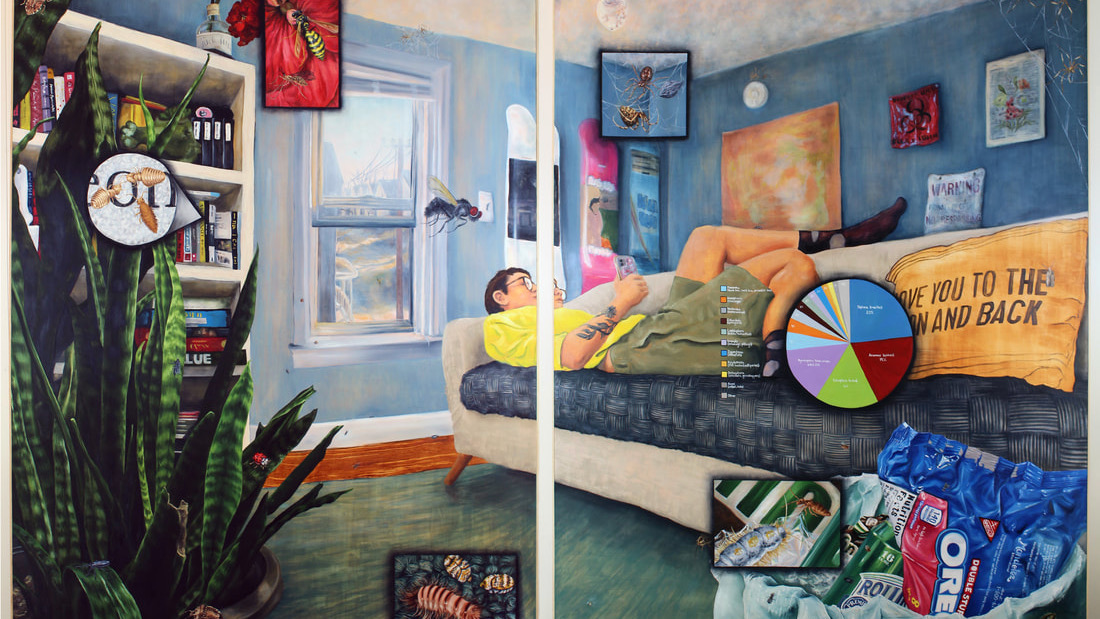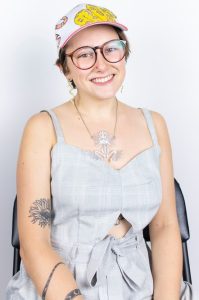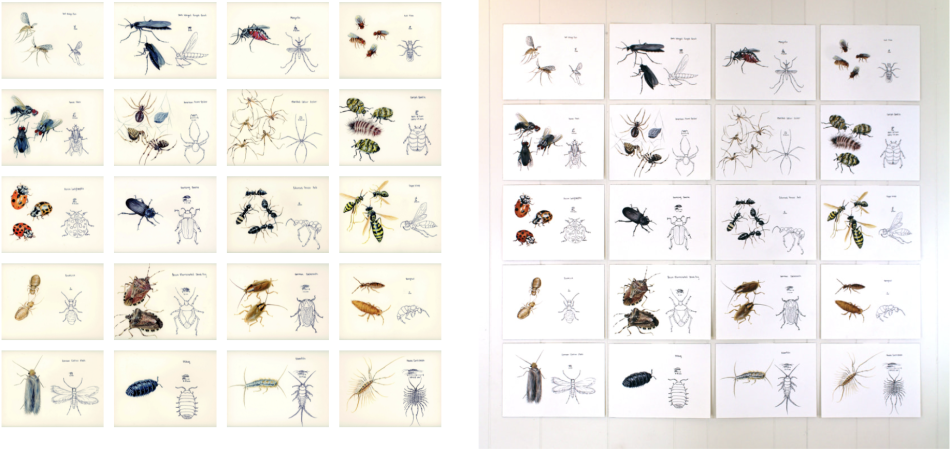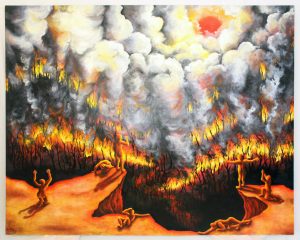
Eleanor Olson "Housemates" (2021) Oil on masonite, two panels each 48x60 in.
Like many of us, artist Eleanor Olson found themselves reconnecting with the nature in their home during the lockdown months of the pandemic. This lead them to the works of Rob Dunn and The Public Science Lab and then, straight to their canvas.
In this delightful conversation, Eleanor and I chat about their inspirations, the future of art in their spaces, and… a lot about skeletons.
Listen below + transcript underneath!
[Michelle] Meet Eleanor Olsen. An artist and recent graduate from the Rhode Island School of Design. Eleanor, like most of us, became reacquainted with the wildlife in their home during the 2020 lockdowns. And while Googling “camel cricket pictures,” stumbled across the works of Rob Dunn and the public science lab. This led to an email, which led to another email, a zoom call, and this lovely conversation about their artistic and ecological path, a detailed discussion about lots of skeletons, and a call for more ecosystem positivity in the arts and sciences. First, I asked Eleanor to start from the beginning…

[Eleanor] I was really interested in Rob’s book when he talks about the idea of creating biomes in your home that naturally get rid of the things we don’t want. And I was like, oh my God, that is like, it just, it’s a concept I’ve never thought about before. Because, you know, like my whole life it’s like, okay, if something’s dirty, go get some bleach, spray it down, get rid of it. You know, we don’t want any germs in our house. And it’s really, really, really like empowering, I think. Um, this idea that we could have beautiful ecosystems in our homes that actually do really great things for us and we do good things for them. And we don’t need to just see everything like it’s either a good bacteria or a bad bacteria.
I’m really interested in making people look at my work and think about how they exist in the world and what things live around them, and who are their neighbors and who are the things that they care about. I started looking around my house and trying to remember bugs that I’d found before. So then I started making like a bunch of lists and drawings and then it turned into a collage and then it became a painting, and then I was like, oh my God. Like, I really just loved this like train of thought. and now it’s a whole series and not really sure where it’s going to go next!
[Michelle] Great Eleanor! What is your superhero origin story how do you connect the dots of your past to get to this point now?
[Eleanor] I was born in Ann Arbor, Michigan, and Ann Arbor has like a very strong connection to nature. I really started doing art when I was a little kid. When I was 11, I attended the Blue Lake Fine Arts summer camp and it’s an 11 day intensive period where you take classes from nine o’clock in the morning until five o’clock at night. This is what I want to do, like, if I could spend every single day of my life doing art for like eight hours every single day, that is what I want.
Then I discovered, uh, the Rhode Island School of Design, which is one of the best art schools in the country. They have this space that’s called the RISD Nature Lab. It changed… everything for me, honestly. It was started in the 1930s by a professor at RISD, and the main tenant of her teaching was that the best way to learn how to draw something is to draw it from life. So, she started this natural history collection and it now has over 60,000 objects that range from a full-on like taxidermy bear, a ton of skeletons of all sorts of things, you know, like fish, skeletons, lizards, small mammals, birds, seed pods, insects, like anything you can imagine, really. And in addition to that, they also have a live lab. They had like a turtle, a snake, a bunch of hissing cockroaches, and then they have a wet lab, too. And I went there every single day and I eventually applied and got a job there. I worked for three years doing aquatic and marine animal care, and I just fell in love. And I got really, really exposed to, like, all sorts of, like, science that I’d never really thought about before.
I eventually took this class that I think really changed how my work was being focused and it was an urban ecology class. And that’s actually where I read the study that your lab had put out. That, that class really just totally changed it for me, it just really made me start to realize that like, nature is not something that you can ever separate from human life, like, we are all a part of nature all the time. And this idea that a city is devoid of nature, I think, just allows us to have that cognitive dissonance of like this isn’t something that really affects me or this isn’t something that I even really live around all the time. And it’s like, no, you are constantly surrounded by this incredibly interesting ecosystem.

So then after that, I started making a bunch of paintings that were about things from the nature lab specifically. When I started listening to Never Home Alone, I did not know that Rob had written the study. That was like a very bizarre moment for me. I was looking up pictures of camel crickets, and that’s how I found the cover of the book. And I was like, oh, I have to read this book. And then I was literally working on my painting, listening to it, and he’s talking about North Carolina and I’m like, “Oh, that’s so funny. That’s where that study was done.”

And then I keep listening to it and I was like, oh my God. And then I went back and I looked at the study and I was like, Robert Dunn is Rob Dunn. And I freaked out. I called my friend and I was like, you do not understand what has happened to me. I felt like the whole universe aligned in that moment. It’s definitely something that I think made me like slow down and think of like, okay, so how do I want to relate to the world around me? Is making a bunch of paintings being like the whole world is on fire, is that actually making somebody turn inward and like think a little bit more critically about the way that they interact with their relationship?
Because I think , that’s going to be the way out of this. It’s not going to be panicking. It’s going to be realizing like, oh, having some beatles in my house it’s like maybe not the worst thing in the world. Maybe there are good things that happened because I allow this whole colony of spiders to exist, you know? We’re just constantly moving towards this, sterilization of the interior of our homes and it’s just something that makes me really bummed out.
[Michelle] Yeah. Yeah. And, we’ve chatted a lot here off the record about the shifts in how ecologists talk about the future of life and ecosystems, how scientists are talking about the future of life more adaptation versus doom and gloom… Do you see the art world shifting in any way in how artists are portraying the future of life on Earth?
[Eleanor] I think that there is a lot more people right now who are making work that is really trying to get people to think more positively about the ecosystems that they live within. I think it’s a lot more interesting to make work that makes people think about the intricacies of the ecosystem, as opposed to just kind of that existential dread of, oh, we’re just making everything extinct. So like seeing that and seeing other people make work that’s more celebratory instead of we’re all screwed, there’s no coming back. And, put it into somebodies mind that like that little teeny, tiny weed that’s growing in your sidewalk doesn’t need to be pulled. It actually does something really wonderful in the world. It’s not about like a hopefulness, it’s more of just about like, okay, how can we like reframe this? You know, like how can we put those pieces back in?
I was like reaching this point where I was like, is that helpful? Is that helpful to me? Um, because I feel like everyone knows that the world is dying and I don’t know how much another painting about that is really, like, making a person think about the way that they interact with the world. That’s why I like immediately returned to that urban ecology class and to the study about all the bugs that live in our houses with us. And I was like, this is what I want to do.
View and purchase some of Eleanor’s work here.